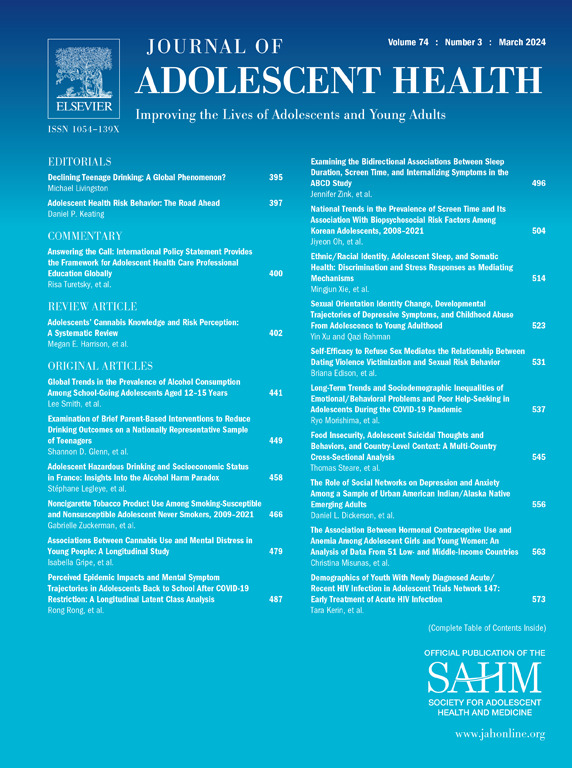来自青少年大脑认知发展研究的发现:高经济逆境的青少年,奖励加工区域的皮质下体积较小,体重增加。
IF 4.5
2区 医学
Q1 PEDIATRICS
引用次数: 0
摘要
目的:经济逆境与皮层下神经发育改变和肥胖风险相关。然而,没有研究将这些关系联系起来。食物摄入受下皮层影响;因此,我们研究了经济逆境是否会调节青春期早期神经发育和身体质量指数(BMI)之间的双向关系。方法:数据来自青少年大脑认知发展研究(nT0 = 3,606)[9/10岁,100%健康体重,50.8%男性;71.4%白人,15.6%拉丁裔,869名有财务困难的年轻人];nT2 = 2395[11/12岁,11.2%超重/肥胖];没有兄弟姐妹)。财务困境是评估一个七项二元回答问卷。采用混合模型考察了金融逆境(皮质下体积(8个双侧区域)∗时间)对BMI的人群水平影响,采用多指标双变量潜在变化评分模型考察了跨域夫妇的个体差异和时间优先性。结果:在11/12岁时,较高的经济逆境与较大的BMI增加(即体重增加)相关,与双侧伏隔核、尾状核和右侧苍白球的体积呈负相关。双变量潜在变化评分模型显示,在有三次或更多财务不良经历的青少年中,较小的皮质下体积预示着更大的体重增加。讨论:我们的研究结果表明,经济逆境可能会改变与奖励处理和食物摄入控制相关的皮层下发育区域,并可能导致体重增加(即2年内体重指数增加)。通过阐明体重增加自然过程中的这些机制,我们强调了肥胖发展的潜在神经社会经济风险因素。本文章由计算机程序翻译,如有差异,请以英文原文为准。
Smaller Subcortical Volume in Reward Processing Regions Precedes Weight Gain in Youth With High Financial Adversity: Findings From the Adolescent Brain Cognitive Development Study
Purpose
Financial adversity has been associated with altered subcortical neurodevelopment and obesity risk. However, no studies have examined these relationships in tandem. Food intake is influenced by the subcortex; thus, we examined whether financial adversity moderated bidirectional relationships between neurodevelopment and body mass index (BMI) in early adolescence.
Methods
Data were gathered from the Adolescent Brain Cognitive Development Study (nT0 = 3,606 [9/10 years, 100% healthy weight, 50.8% male; 71.4% White, 15.6% Latino, 869 youth with financial adversity]; nT2 = 2,395 [11/12 years, 11.2% overweight/obese]; no siblings). Financial adversity was assessed on a seven-item binary response questionnaire. Population-level effects of Financial Adversity∗Subcortical Volume (8 bilateral regions)∗Time on BMI were examined with mixed models, while individual differences and temporal precedence of cross-domain couples were examined with a Multiple Indicator Bivariate Latent Change Score model.
Results
By 11/12 years, higher financial adversity was associated with a greater increase in BMI (i.e., weight gain) and a negative association with volume in the bilateral accumbens, caudate, and right pallidum. The Bivariate Latent Change Score model showed that smaller subcortical volume preceded and predicted greater weight gain among youth with three or more financial adverse experiences.
Discussion
Our findings suggest that financial adversity may alter subcortical development regions associated with reward processing and food intake control, and potentially contribute to greater weight gain (i.e., increased BMI trajectory over a 2-year period). By elucidating these mechanisms within the natural progression of weight gain, we highlight a potential neurosocioeconomic risk factor for obesity development.
求助全文
通过发布文献求助,成功后即可免费获取论文全文。
去求助
来源期刊

Journal of Adolescent Health
医学-公共卫生、环境卫生与职业卫生
CiteScore
10.40
自引率
3.90%
发文量
526
审稿时长
46 days
期刊介绍:
The Journal of Adolescent Health is a scientific publication dedicated to enhancing the health and well-being of adolescents and young adults. Our Journal covers a broad range of research topics, spanning from the basic biological and behavioral sciences to public health and policy. We welcome a variety of contributions, including original research papers, concise reports, literature reviews, clinical case reports, opinion pieces, and letters to the editor. We encourage professionals from diverse disciplines such as Anthropology, Education, Ethics, Global Health, Health Services Research, Law, Medicine, Mental and Behavioral Health, Nursing, Nutrition, Psychology, Public Health and Policy, Social Work, Sociology, and Youth Development to share their expertise and contribute to our mission of promoting adolescent health. Moreover, we value the voices of young individuals, family and community members, and healthcare professionals, and encourage them to submit poetry, personal narratives, images, and other creative works that provide unique insights into the experiences of adolescents and young adults. By combining scientific peer-reviewed research with creative expressions, our Journal aims to create a comprehensive understanding of the challenges and opportunities in adolescent and young adult health.
 求助内容:
求助内容: 应助结果提醒方式:
应助结果提醒方式:


